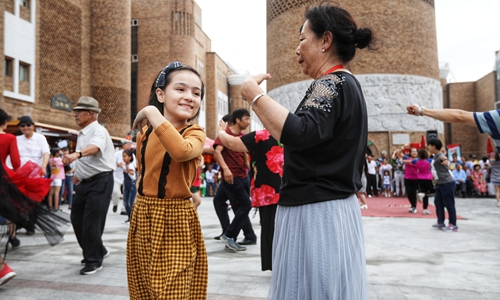NYT's 'Xinjiang files' not worth being 'leaked,' unfounded accusations against China: scholar

Residents in Urumqi, capital of Northwest China's Xinjiang Uyghur Autonomous Region, dance in a square. (Photo: Cui Meng/GT)
Chinese scholar Zheng Liang released a report on Tuesday analyzing the so-called leaked files on Northwest China's Xinjiang Uyghur Autonomous Region, saying that the authenticity of these files remains questionable, and they could not prove allegations about China's alleged oppression of Uyghur Muslims as hyped by some Western media.
The New York Times (NYT) recently published a report claiming they obtained 403 pages of "internal documents," which "provided an unprecedented inside view of the continuing clampdown in Xinjiang."
The so-called leaked files could not prove the NYT's accusations of China oppressing ethnic groups and the Muslims, and the source of these files is unknown and the authenticity remains questionable, according to Zheng's report.
Zheng works as a research fellow in the School of Journalism and Communication of the Guangdong-based Jinan University on Tuesday.
"Xinjiang is my hometown. I grew up in [the regional capital] Urumqi and have studied Xinjiang affairs for more than 10 years," Zheng told the Global Times.
NYT's report attracted the attention of Zheng, who found that "no relevant organizations have made valuable and deep analysis on the so-called leaked files."
"As a scholar who has studied Xinjiang affairs from a journalism perspective for a long time, I felt that there were too many bubbles in the news of the West on Xinjiang. Some Western media hype these topics without logic or reasonable discussions. I have the responsibility to add valuable opinions," Zheng told the Global Times.
Zheng said he wrote the report out of academic interests, and no organization or individual had asked him to do so.
For a long time, China's ethnic and religious policies as well as counter-terrorism efforts have been misunderstood. One reason is these policies and counter-terrorism measures are obscured by the language used in documents, Zheng wrote in the report.
Although interpreted out of context, the so-called leaked files obtained by The New York Times offer materials for the international community and media to analyze and study China's ethnic and religious policies and its practices. And Western media rely on these files in reports full of bias toward China, Zheng said.
Content regarding official ethnic and religious policies, and measures on counter-terrorism and de-radicalization from the "leaked files" are not against China's current policies. Nothing in these files was worth being "leaked," read the scholar's report.
When it comes to China's Xinjiang policies, one view shared by many Western media is that the reason for terrorist activities in Xinjiang is the Chinese government's alleged oppression of Uyghurs.
"This opinion is a subjective judgment of the Western media without any solid investigation, and has gradually become an unchallengeable 'politically correct' position for these media. However, no evidence could prove that view," the report said.
The NYT seemed surprised to find from the "leaked files" that internal talks to senior officials include contents on "not discriminating against Uyghurs and respecting their right to worship" and not "overreacting to natural friction between Uyghurs and Han people."
Zheng said that Western media, including the NYT, have fallen into the stereotype of reporting China's Xinjiang's affairs, and that the "leaked files" somewhat contradicted their previous conceptions. Their surprise also showed they lack sufficient knowledge of China's ethnic and religious policies.
"The NYT's report on so-called leaked files is another eye-catching way to gloss over their long-standing prejudice against China," Zheng said.
Terrorism threat
Zheng noted that NYT's report also showed that their reports about China's Xinjiang often conflicted with each other. For example, the NYT referred to an explosion in Urumqi on April 30, 2014 and the terrorist attack at Kunming railway station on March 1.
"Out of ideological considerations, the NYT did not call the two cases 'terrorist attacks' in its report but it still used words like 'suicide bombing' and 'assailants', and listed the astonishing casualty count. This showed that the newspaper agreed that Xinjiang has been threatened by terrorism," Zheng said.
Zheng cited the figures from a white paper on the fight against terrorism and extremism as well as human rights protection in Xinjiang, which said, "Incomplete statistics show that from 1990 to the end of 2016, separatist, terrorist and extremist forces launched thousands of terrorist attacks in Xinjiang, killing large numbers of innocent people and hundreds of police officers, and causing immeasurable damage to property."
Although the white paper, which was released by the Information Office of the State Council in March did not give a specific number of casualties from terrorism, it showed the stern problem of how Xinjiang has been under the threat of terrorism and how the influence of terrorism also extended its shadow to other Chinese provinces.
"It is a pity that the Western media did not understand this, and the NYT's report also showed they lack basic knowledge of China's Xinjiang policies and its counter-terrorism measures," Zheng said.
